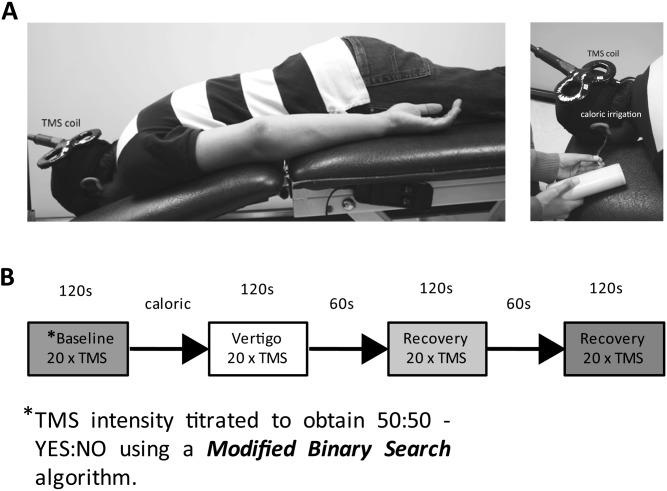Figure 1.
Apparatus and experimental protocol. (A) Apparatus. Subjects lay prone to facilitate TMS access to the occiput. The subjects placed their face in an aperture that allowed free breathing and comfortable placement of a blindfold. This configuration also meant that the subject's head was stabilized within the aperture and thus restricted any head movement as a consequence of the elicited vestibular-colic response. The figure also shows the water irrigation tube inserted into the external auditory meatus. The water outflow was captured by a semirigid channel that sat below the pinna. The water-capture channel and coil holder are not shown for clarity. (B) Protocol. A single experimental RUN, consisting of 4 phases, is shown schematically. Each volunteer was subject to 4 RUNS. The entire experiment was conducted in low ambient light and with the subjects' eyes blindfolded. Phosphene threshold in terms of percentage of maximal TMS stimulator output was obtained prior to each “run” using a modified binary staircase algorithm (Mobs—Tyrell and Owens 1988). The average TMS threshold intensity obtained from 2 Mobs trials was then used for obtaining baseline responses (i.e., no vestibular activation) during which 20 TMS pulses were applied at threshold level at 6 s intervals. “Subjects' report of phosphene presence”—subjects were instructed to answer “yes” or “no” according to whether they perceived a phosphene immediately after each TMS pulse. The Mobs thresholding was repeated if the number of “yes” responses did not fall between the range 8–12 (inclusive) for 20 TMS pulses during the baseline. The TMS intensity was then kept constant for a given run. On average, each run took 20 min (including Mobs thresholding), with each run followed by a 10 min break. All subjects had both hemispheres and both ears irrigated (4 runs). The order of the ear/hemisphere sequence was balanced across 12 subjects. “Subjects' phosphene SIZE and INTENSITY reporting”—after every successful baseline sequence (of 20 TMS pulses), subjects were told to apply a subjective average rating of 3/5 for phosphene size and intensity elicited during the baseline. Immediately following each of the postbaseline phases, each with 20 TMS pulses (i.e., vestibular activation and 2 recovery phases), subjects were asked to rate phosphene size and intensity out of 5 as compared with the baseline rating of 3/5. This rating was updated for each new baseline for each of the 4 “runs.” Consistent with the literature, V1 phosphenes tended to be small and point like lying near or across the midline. In contrast, V5/MT phosphenes were usually large, for example, pizza wedges, and peripheral.

